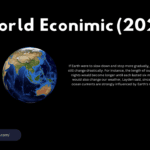World Econimic 2024


The United States of America, China, Japan, Germany, and India are the largest economies in the world in 2024, as per their GDP data. GDP serves as a key metric for assessing the magnitude of a nation’s economy. The conventional approach for gauging a country’s GDP involves the expenditure method, wherein the total is derived by aggregating expenditure on fresh consumer goods, new investments, government outlays, and the net value of exports.
The top 10 largest economies in the world in 2024
1 : The United States of America

- GDP: $27,974 billion
- GDP By Country Per Capita (Thousands): $83.06
- Annual GDP Growth Rate: 1.5%
The United States upholds its status as the major global economy and richest country, steadfastly preserving its pinnacle position from 1960 to 2023. Its economy boasts remarkable diversity, propelled by important sectors, including services, manufacturing, finance, and technology. The United States enjoys a substantial consumer market, fosters innovation and entrepreneurial spirit, possesses resilient infrastructure, and experiences advantageous business conditions.
2 : China


- GDP: $18,566 billion
- GDP By Country Per Capita (Thousands): $13.16
- Annual GDP Growth Rate: 4.2%
China has witnessed a notable upsurge in its economic progress, moving from the fourth rank in 1960 to the second rank in 2023. The Chinese economy predominantly hinges upon manufacturing, exports, and investment. It proudly possesses an extensive workforce, robust governmental backing, infrastructural advancements, and an expeditiously expanding consumer market.
3 : Germany


- GDP: $4,730 billion
- GDP By Country Per Capita (Thousands): $56.04
- Annual GDP Growth Rate: 0.9%
The German economy strongly focuses on exports and is renowned for its precision in the engineering, automotive, chemical, and pharmaceutical sectors. It derives advantage from its proficient labour force, robust research and development initiatives, and a pronounced commitment to fostering innovation.
4 : Japan


- GDP: $4,291 billion
- GDP By Country Per Capita (Thousands): $34.55
- Annual GDP Growth Rate: 1.0%
Japan’s notable economy is distinguished by its progressive technology, manufacturing prowess, and service industry. Prominent sectors encompass automotive, electronic, machinery, and financial domains. Moreover, Japan garners recognition for its unwavering work ethic, pioneering technological advancements, and exceptional exports of superior quality.
5 : India

- GDP: $4,112 billion
- GDP By Country Per Capita (Thousands): $2.85
- Annual GDP Growth Rate: 6.3%
India is ranked 5th in world’s GDP rankings in 2024. India’s economy boasts diversity and swift growth, fuelled by key sectors such as information technology, services, agriculture, and manufacturing. The nation capitalises on its broad domestic market, a youthful and technologically adept labour force, and an expanding middle class.
6 : United Kingdom

- GDP: $3,592 billion
- GDP By Country Per Capita (Thousands): $52.43
- Annual GDP Growth Rate: 0.6%
The economy of the United Kingdom comprises a blend of services, manufacturing, finance, and creative sectors. London functions as a worldwide financial centre, enticing foreign investments. The economic expansion of the UK is additionally shaped by its trade alliances and globalisation.
7 : France


- GDP: $3,182 billion
- GDP By Country Per Capita (Thousands): $48.22
- Annual GDP Growth Rate: 1.3%
France is expected to have a GDP estimated at 2,920 billion US dollars in 2023. The economy of France is characterised by diversification, emphasising industries such as aerospace, tourism, luxury goods, and agriculture. France is renowned for its robust social welfare system, well-developed infrastructure, and substantial investment in research and development.
8 : Italy

- GDP: $2,280 billion
- GDP By Country Per Capita (Thousands): $38.93
- Annual GDP Growth Rate: 0.7%
Italy boasts a highly developed market as the third-largest economy in the European Union. The nation is known for its influential and pioneering business sector and diligent and competitive agricultural industry.
9 : Brazil


- GDP: $2,272 billion
- GDP By Country Per Capita (Thousands): $11.03
- Annual GDP Growth Rate: 1.5%
The Brazilian economy exhibits a breadth of sectors, encompassing agriculture, mining, manufacturing, and services. Notably, it is a prominent global hub for agricultural production and exportation. Several factors, including commodity prices, domestic consumption, and the advancement of infrastructure, shape the growth of Brazil’s economy.
10 : Canada


- GDP: $2,242 billion
- GDP By Country Per Capita (Thousands): $55.53
- Annual GDP Growth Rate: 1.6%
The Canadian economy relies heavily on its abundant natural resources, encompassing oil, gas, minerals, and timber. Moreover, the nation boasts a thriving services sector, a well-established manufacturing industry, and a steadfast dedication to fostering innovation and technological advancements.
world ecconomics list kya kya hota hai :
It looks like you’re asking for a list of topics related to world economics. Here is a comprehensive list covering various aspects of global economics:
- Macroeconomics:
- Economic indicators (GDP, inflation, unemployment)
- Fiscal policy
- Monetary policy
- International trade and finance
- Economic growth and development
- Microeconomics:
- Supply and demand
- Market structures (perfect competition, monopoly, oligopoly)
- Consumer behavior
- Producer theory
- Cost analysis and pricing strategies
- International Economics:
- Balance of payments
- Exchange rates and foreign exchange markets
- Trade theories (comparative advantage, protectionism)
- Globalization and its impact on economies
- International trade agreements (WTO, NAFTA, EU)
- Development Economics:
- Poverty and inequality
- Economic development strategies
- Human capital and education
- Role of institutions in economic development
- Sustainable development goals (SDGs)
- Financial Economics:
- Financial markets (stock markets, bond markets, derivatives)
- Banking and financial institutions
- Risk management and insurance
- Corporate finance
- Financial regulation and policy
- Labor Economics:
- Labor market theories
- Wage determination
- Unemployment and its types
- Labor market policies (minimum wage, labor unions)
- Human capital investment
- Public Economics:
- Government expenditures and revenues
- Taxation and tax policy
- Public goods and externalities
- Social welfare programs
- Government debt and fiscal sustainability
- Environmental Economics:
- Market failures related to environmental issues
- Cost-benefit analysis of environmental policies
- Sustainable development and resource management
- Carbon pricing and emissions trading
- Renewable energy economics
- Behavioral Economics:
- Psychological factors in economic decision-making
- Behavioral biases and heuristics
- Nudge theory and policy implications
- Experimental economics
- Consumer behavior insights
- Health Economics:
- Healthcare systems and financing
- Cost-effectiveness analysis of healthcare interventions
- Health insurance and risk pooling
- Global health economics challenges
- Economic evaluation of public health programs
These topics collectively cover various dimensions of world economics, from macro-level policies and international trade to micro-level consumer behavior and specialized areas like health and environmental economics. Studying these topics helps in understanding the complexities of global economies and their interconnectedness in today’s world. Each of these areas plays a vital role in shaping economic policies, business decisions, and societal welfare on a global scale.
FAQ :(Frequently Asked Questions)
1 : What are the poorest countries in the world?
ans : South Sudan


























Best content